An insufficient iron intake can lead to anaemia (fatigue, pallor, palpitations, decrease in intellectual performance, weakening of the immune system). A risk of iron deficiency is more frequently seen in women: of child-bearing age (often due to heavy periods) who are pregnant on a vegan diet athletes with digestive ulcers Iron deficiency is one of the most common deficiencies in the world. However, iron can also accumulate easily in the body, as there are only a few systems for eliminating it. The daily recommended dose is approximately 15 mg/day for women. But several parameters should be considered during the different stages of a woman's life. Menstrual blood loss is around 0.6 mg/day, in addition to unavoidable losses (0.8 mg/day), i.e. 1.4 mg/day. The highly variable level of individual menstrual blood loss means that 10% of women have iron needs of over 2.3 mg/day, and 5% need 2.8 mg/day. The needs of some teenage girls can exceed 3 mg/day during a growth spurt. Lastly, it is important to consider the various methods of contraception, that can significantly influence menstrual flow. During a reproductive period, women have an increased need of around 0.5 to 1.0 mg/day. This increased need is not due to growth, as in teenage girls, but will vary depending on the contraception used, pregnancies and parity. Expressed in terms of body weight, the needs of menopausal women and of men are comparable. Taking an iron supplement is recommended subject to medical advice. Even taken at a moderate dose, iron can cause abdominal pain and nausea, or aggravate certain symptoms (digestive ulcers) or illnesses (Crohn's disease).
Good for
Energy, combating anaemia


